Pashmina goats, also recognized as Changthangi Goats, are a distinguished breed of domesticated goats. These goats are famous for their opulent and exquisitely fine wool fibres, widely known as Cashmere. These remarkable creatures hail from the high-altitude terrain nestled within the Himalayan regions of Kashmir. Cashmere fibres have garnered an esteemed reputation for their exceptional softness, innate warmth, and remarkable lightness. This, hence, renders them the favoured selection for crafting top-tier garments. Additionally, luxurious shawls and an array of exquisite accessories come from Cashmere. Cashmere is the same material which artisans process to make the world-famous Pashmina shawls of Kashmir.
Throughout history, Pashmina goats have held a pivotal role in shaping both the economy and cultural heritage of the Himalayan regions. These remarkable creatures trace their origins back over two millennia. It was a time when they were meticulously bred by nomadic tribes inhabiting the region. Their prized wool fibres became the foundation upon which an industry of immense significance thrived.
Evolution of Pashmina and the Pashmina Goat
Over time, the Pashmina industry evolved and prospered, firmly establishing itself as a cornerstone of the region's economic activity. Cashmere, renowned for its extraordinary softness and warmth, emerged as a highly sought-after export commodity. It hence, found its way to distant European markets. This remarkable material, derived from the diligent efforts of these resilient goats, not only contributed substantially to the local economy but also carved a prominent place for itself in the annals of fashion and luxury.
In the contemporary landscape, the Pashmina goat retains its pivotal role for the masses. It acts as a lifeline for numerous rural communities nestled within the Himalayas. These goats serve as an invaluable means of both income generation and subsistence for these remote populations. Furthermore, it's worth noting that the Pashmina industry has played a substantial role in fostering the broader economic progress and advancement of the entire region.
Physical Characteristics of a Pashmina Goat
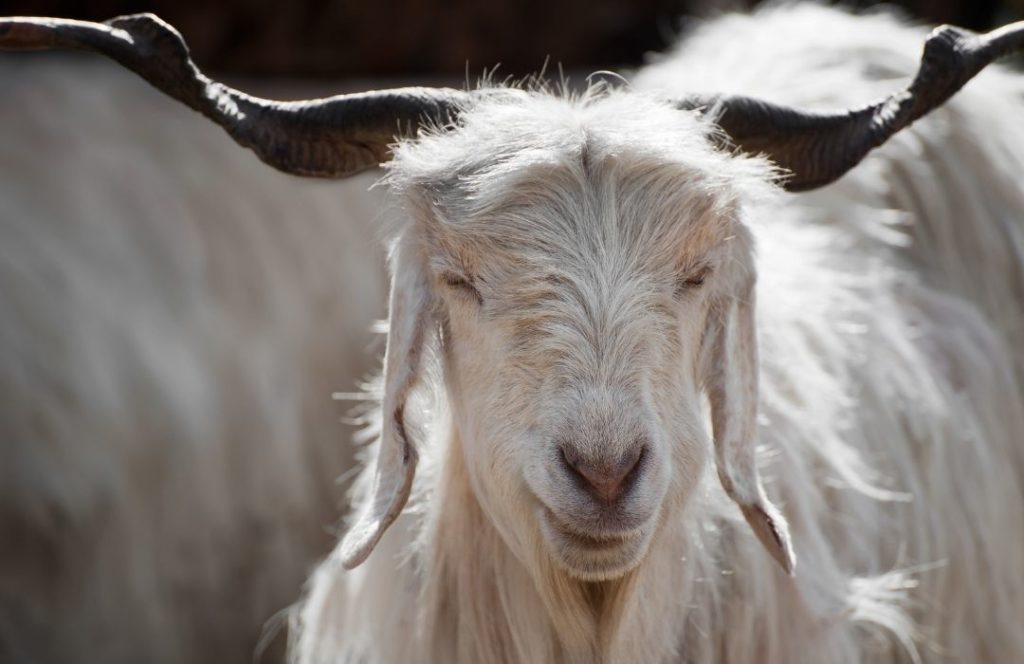
The Pashmina goat, scientifically known as Capra Hircus, has a lineage that stretches back over centuries. Researchers believe it to have originated in the high-altitude regions of the Himalayas. And ever since, these goats have thrived in the challenging terrains and climates of this majestic mountain range. Their adaptation to the harsh environment has endowed them with distinctive physical traits. These features set them apart from other goat breeds.
Size and Stature
One of the most noticeable features of a Pashmina goat is its modest size. Adult males weigh between 50 to 65 kilograms, while adult females typically weigh between 35 to 50 kilograms. Their relatively compact stature, long slender legs, and slender frame make them well-suited to navigate the steep, rocky terrains of the Himalayas.
Coat Colour
A Pashmina goat boasts a captivating array of coat colours. These hues range from creamy white and beige to shades of grey and brown. The diversity of coat colours among the Pashmina goat adds further to the charm and allure of their wool. This hence allows for a range of natural colour options when crafting Pashmina products.
Distinctive Horns
A Pashmina goat typically possesses twisted, corkscrew-like horns that curve backwards. These elegantly spiraled horns are not only a distinctive physical feature but also serve a functional purpose. They enable the goats to access sparse vegetation in rocky terrains, thereby, showcasing nature's remarkable adaptability.
Habitat of a Pashmina Goat
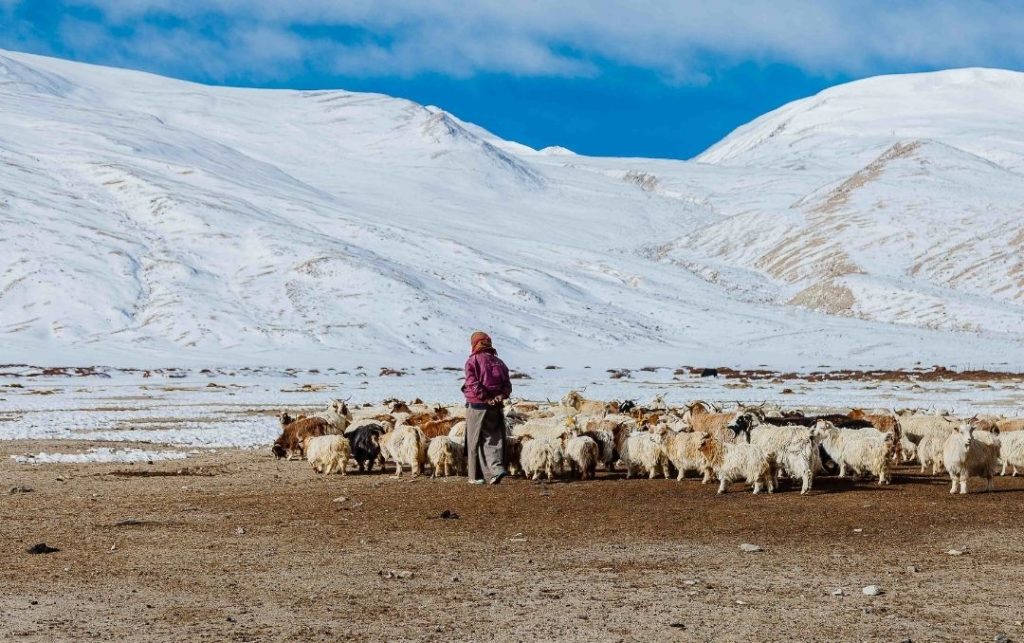
The natural habitat of a Pashmina goat unfolds in the awe-inspiring high-altitude regions of the Himalayas. It inhabits particularly the enchanting locales of Ladakh. These goats, the bearers of the coveted Cashmere wool, have made these extreme environments their home. Hence, they have, for centuries, showcased remarkable adaptations to the challenging surroundings. As we journey the habitat of these amazing creatures henceforth, we'll discover how these resilient animals thrive in a world where temperatures plummet and vegetation is scarce.
Habitat Overview
Pashmina goat is a true master of survival in some of the harshest conditions on Earth. Its habitat is characterized by extreme temperature fluctuations, with mercury levels plummeting well below freezing during the biting winters. These majestic mountain regions boast altitudes that range from 3,000 to 5,000 meters above sea level. This is, certainly, a stark reminder of nature's grandeur and severity.
Natural Grazers in the High Himalayas
In their picturesque habitat, Pashmina goat roams in herds, navigating the undulating landscapes with a sense of purpose. The sparse vegetation that dots the terrain becomes their nourishment. Hence, the goats display their adaptability by feasting on a diet of grasses, shrubs, and lichens. This high-altitude cuisine not only sustains them but also contributes to the quality of their prized Cashmere wool.
Geographical Distribution
The geographical range of a Pashmina goat is the lofty reaches of the Himalayas. This harsh region has been a sanctuary that these animals have inhabited for generations. The heart of Pashmina goat territory lies in the Indian state of Jammu and Kashmir. Here, the majority of these goats call home. Indeed, the rugged beauty of the landscape mirrors the resilience of these animals.
While Jammu and Kashmir claim the lion's share of Pashmina goats, they also make a rare appearance in the neighbouring regions of Nepal and Tibet. In these areas, they exist in much smaller numbers. This, indeed, is a testament to their ability to adapt and thrive in a range of environments within the Himalayan expanse.
Braving the Elements
Survival in the natural habitat of Pashmina goats requires resilience and adaptation. The climate here is harsh. On one hand, there are long, unforgiving winters and on the other hand, the brief and cool summers. As the mercury dips, heavy blankets of snow envelop the landscape, creating a formidable challenge for both flora and fauna.
Diet and Nutrition - The Pashmina Goat
In the world's most breathtaking landscapes, where the air is crisp and the terrain unforgiving, the Pashmina goat thrives. These resilient creatures are not only famous for their fine wool but also for their ability to adapt to the challenging diet and nutritional requirements dictated by their high-altitude habitat. Let's delve into the dietary habits, nutritional needs, and health considerations of these remarkable animals.
Regular Diet
Pashmina goats, classified as herbivores, have perfected the art of foraging in their natural habitat, the high-altitude regions of the Himalayas. Hence, their menu predominantly consists of vegetation, a testament to their adaptability in an environment where sustenance is far from abundant. Here's a glimpse into their feeding habits:
Grazing on Tough Terrain
The high-altitude terrain of the Himalayas presents a unique challenge for Pashmina goats. To thrive in this environment, they've developed a taste for the tough and fibrous. Grasses, shrubs, and lichens that grow amidst rocky outcrops and sparse meadows, thus become their grazing grounds. Their exceptional ability to extract nourishment from these hardy plants is, indeed, a testament to their survival instincts.
Winter Survival Strategy
When winter blankets their habitat in a deep layer of snow, food sources become scarce. It's during these harsh months that Pashmina goats rely on their stored body fat reserves to sustain them. This strategic use of energy reserves ensures their survival until the arrival of more favourable conditions.
Nutritional Requirements
Pashmina goats are not just hardy; they're also high-maintenance when it comes to nutrition. Their diet plays a pivotal role in both their overall health and the quality of the cherished Pashmina wool. Here are their specific nutritional requirements:
The Trio of Essentials: Protein, Energy, Minerals
To produce those exquisite wool fibres, Pashmina goats require a diet rich in some primary components. These are protein, energy, and essential minerals. These nutrients are the building blocks of their health and the quality of their wool:
- Protein: Essential for the growth and maintenance of body tissues, including the prized wool fibres.
- Energy: Needed to power the metabolic processes that keep them active and healthy.
- Minerals: Vital for maintaining bone health, reproductive functions, and overall vitality. Key minerals include calcium, phosphorus, and magnesium.
Health Implications of Malnutrition
The diet and nutrition of Pashmina goats directly impact their well-being. Malnutrition can lead to stunted growth and poor wool quality. This diminishes the very attributes they are famous for. Conversely, overfeeding can result in obesity and related health complications. Furthermore, deficiencies in essential minerals can give rise to bone disorders and reproductive problems. This can affect the overall vitality of the goat population.
Balancing: Meeting Nutritional Needs
Ensuring the health and vitality of Pashmina goats requires a delicate balancing act. Briefly, here are some key considerations to maintain their nutritional well-being:
Natural Grazing
Allowing Pashmina goats access to a variety of vegetation in their natural habitat is ideal. Herders, hence, finely tune their grazing behaviour to meet their nutritional needs.
Supplementary Feeding
There are cases where natural grazing is insufficient. However, supplementary feeding with high-quality feeds and mineral supplements can easily bridge the nutritional gap.
Veterinary Care
Regular veterinary check-ups and monitoring of nutritional status are essential. This is to prevent and address health issues related to diet and nutrition.
The Pashmina Industry
The Pashmina industry is an integral facet of the Himalayan textile landscape, perpetuating centuries-old traditions of wool production and refinement. It's here, in these enchanting realms, that artisans and herders collaborate to cultivate and process the cherished Cashmere wool. Hence, we delve into the essential elements of this industry, where nature and human craftsmanship intertwine.
The Pashmina Goat: Guardians of Luxury
At the heart of the Pashmina industry lies the Pashmina goat, a creature whose significance none can overstate. These goats, primarily bred for their exceptional wool, are the wellspring of the coveted Cashmere fibres. Their role is, therefore, nothing short of pivotal.
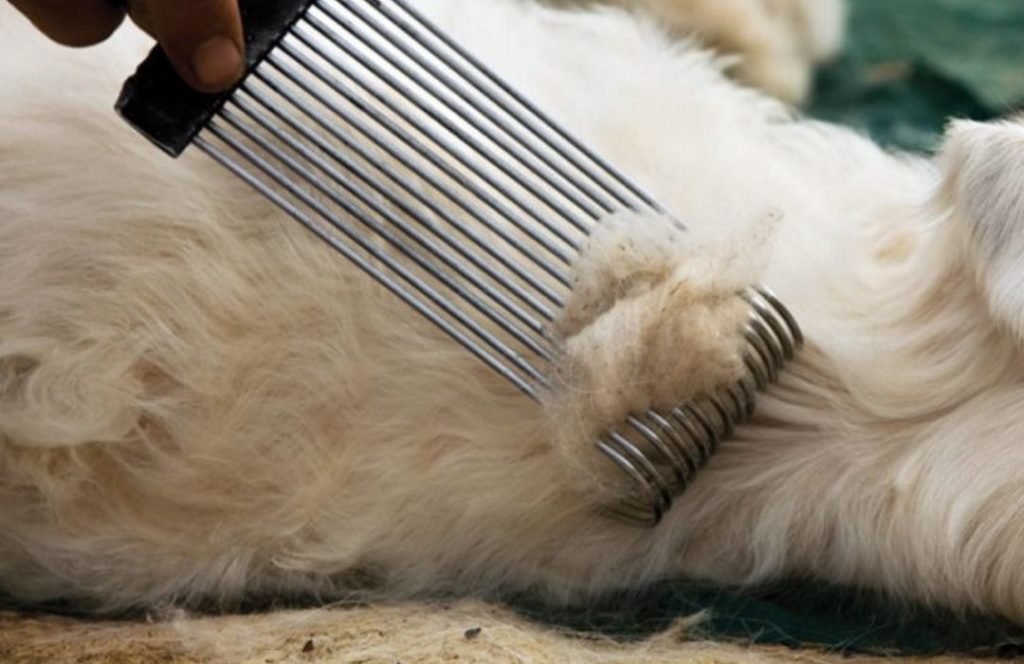
The wool from these goats is unlike any other, and it is the fine, soft undercoat that steals the spotlight. The intricate process of harvesting this precious wool is the combing process. During combing, artisans delicately separate the luxurious undercoat from the coarser outer fibres. This ensures that the prized softness and fineness are preserved.
The Craftsmanship of Pashmina
Once the delicate wool is in hand, the artisans set to work, weaving it into a tapestry of elegance. The exceptional properties of Cashmere wool, including its finesse, insulation, lightness, and durability, make it a favourite for crafting luxurious shawls, scarves, and textiles.
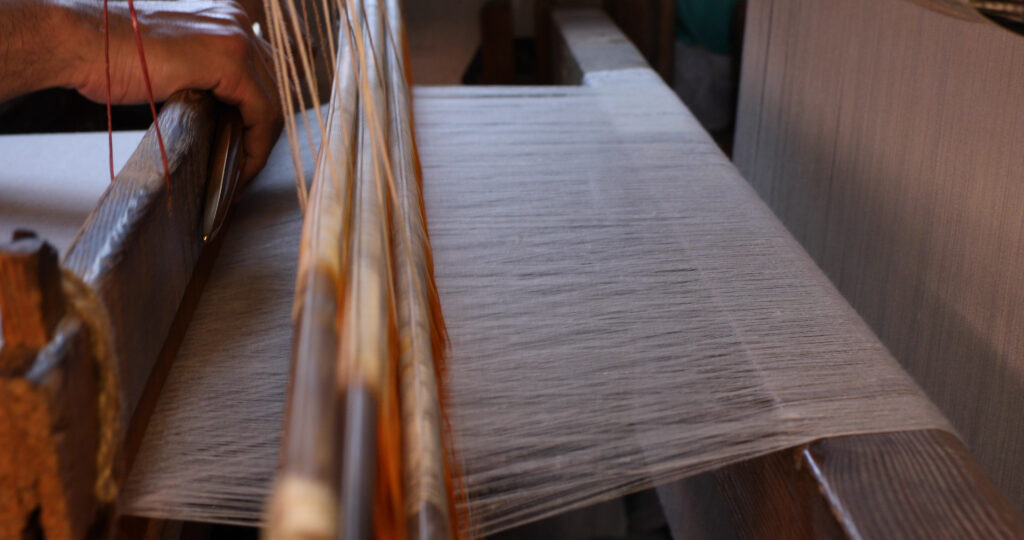
The craft of spinning, weaving, and dyeing has seen unmatched reverence through generations. Artisans ensure that every Pashmina product exudes the timeless allure that has made it famous worldwide. From the intricately woven shawls to the delicately dyed scarves, the Pashmina industry clearly showcases the Himalayan region's rich heritage of textile artistry.
Global Impact
The Pashmina industry transcends borders and captivates the global stage. Pashmina products find their way into the wardrobes of fashion aficionados and luxury enthusiasts across the world. The demand for these exquisite creations not only sustains the livelihoods of artisans and herders in the Himalayan regions but also contributes significantly to the economies of India, Nepal, and Tibet.
Preserving Tradition and Sustainability
Furthermore, as the Pashmina industry continues to flourish, there is a growing recognition of the need for sustainability and ethical practices. People are increasingly making efforts to ensure the welfare of Pashmina goats. This includes promoting responsible grazing and maintaining the delicate balance between tradition and conservation.
The Economic Significance of the Pashmina Industry
In the enchanting realm of Kashmir, the Pashmina industry weaves not only exquisite textiles but also a tapestry of economic opportunities. This industry, deeply rooted in tradition, plays a pivotal role in the region's economy. It offers livelihoods to a diverse spectrum of individuals. However, it faces a dual challenge: balancing economic growth with ethical considerations.
The economic impact of the Pashmina industry is profound. To begin with, it serves as a substantial source of employment for thousands. From the diligent shepherds who tend to the cherished Pashmina goats to the skilled artisans who transform the delicate wool into finished marvels, all depend on it. This industry is a vibrant ecosystem that supports families and communities across the Himalayan region. It helps provide a lifeline to those who rely on it.
Furthermore, the economic influence of the Pashmina industry extends beyond local boundaries. The high-quality Cashmere wool and finished products, renowned for their softness and elegance, are in constant demand in the global market. This export market not only amplifies the industry's reach but also contributes significantly to the overall economic growth of the region.
However, amidst its prosperity, the Pashmina industry grapples with substantial challenges. The soaring demand for Cashmere wool has placed immense pressure on the fragile Himalayan ecosystem. Overgrazing, driven by this demand, threatens the very source of the industry's prosperity - the Pashmina goats. In fact, in some instances, these creatures endure inhumane treatment in the relentless pursuit of higher wool production, raising serious ethical concerns.
Additionally, the allure of Pashmina has spawned a counterfeit market, casting a shadow over the industry's authenticity and integrity. The proliferation of fake Pashmina products not only tarnishes the industry's reputation but also jeopardizes the livelihoods of artisans. These are a blow to those involved in crafting genuine Pashmina treasures.
The Intricate Journey of Pashmina Production
In the enchanting realm of Pashmina production, every exquisite thread tells a tale of craftsmanship, heritage, and meticulous attention to detail. The journey from the Pashmina goat to the creation of luxurious shawls and scarves is unquestionably a mesmerizing odyssey. It weaves together tradition, skill, and the finest natural fibres. Therefore, we embark on a journey through the Pashmina production process, uncovering the secrets of this revered textile artistry.
Harvesting Pashmina Fibre
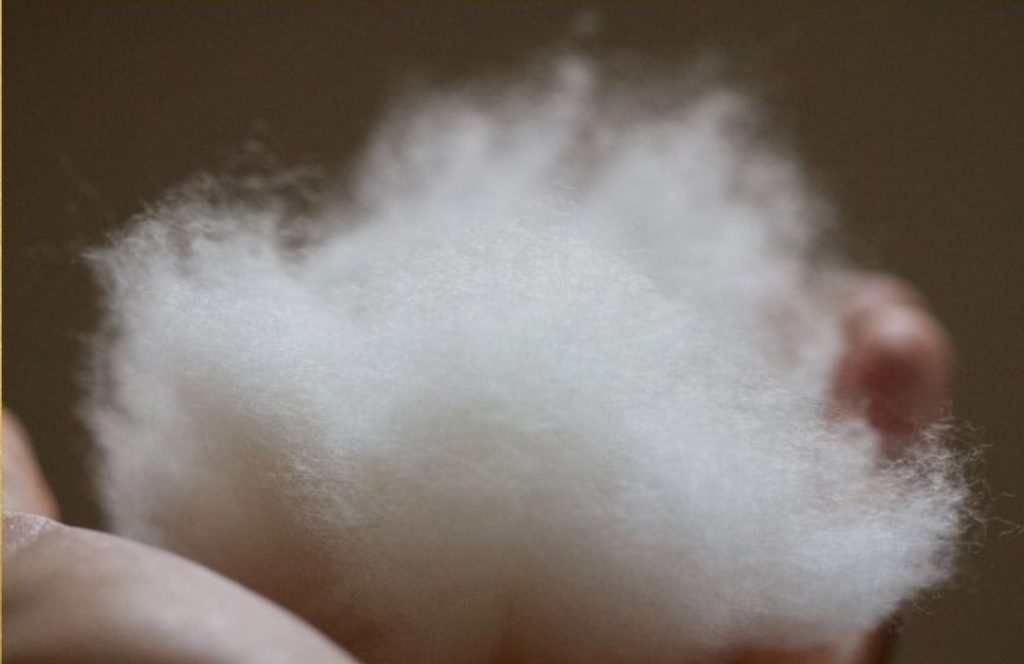
The very essence of Pashmina production begins with the delicate process of harvesting Cashmere fibres. The fibres, famous for their exquisite softness and warmth, are within the undercoat of Pashmina goats. This natural treasure hunt unfolds during the moulting season. It is a pivotal moment that typically graces the Himalayan landscape in the spring.
The combing process is nothing short of an art form. To begin with, artisans set out to extract the fine, soft undercoat of the Pashmina goat's wool. They also take care that the outer, coarser fibres remain untouched. This meticulous procedure safeguards the integrity of the prized Cashmere fibres, hence preserving their delicate texture and remarkable qualities.
Sorting and Grading
Next, with the harvested fibres in hand, artisans commence further procedures. A chapter defined by precision and discernment starts. Now, the fibres undergo a rigorous sorting and grading process, where they are evaluated based on their quality and fineness.
The most coveted Cashmere fibres, characterized by their unrivalled finesse, are usually obtained from the goat's neck and underbelly. These areas yield the softest and most luxurious fibres, the very essence of Pashmina's allure. Meanwhile, coarser fibres, found in other parts of the goat's body, are set aside for different applications.
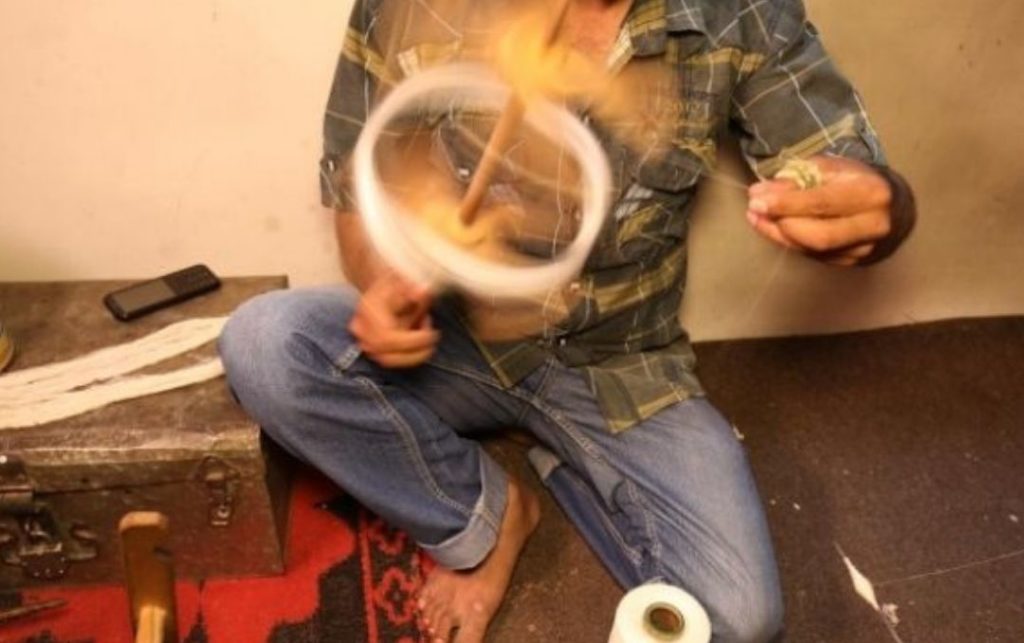
The sorting and grading phase is a crucial juncture in ensuring that only the highest quality fibres are entrusted with the task of becoming part of exquisite Pashmina creations.
Spinning the Thread
Post grading and sorting, Cashmere fibres make their way to the hands of skilled artisans. These individuals are custodians of centuries-old spinning techniques. These artisans carefully spin the fibres into yarn using traditional methods, an art form that has been passed down through generations.
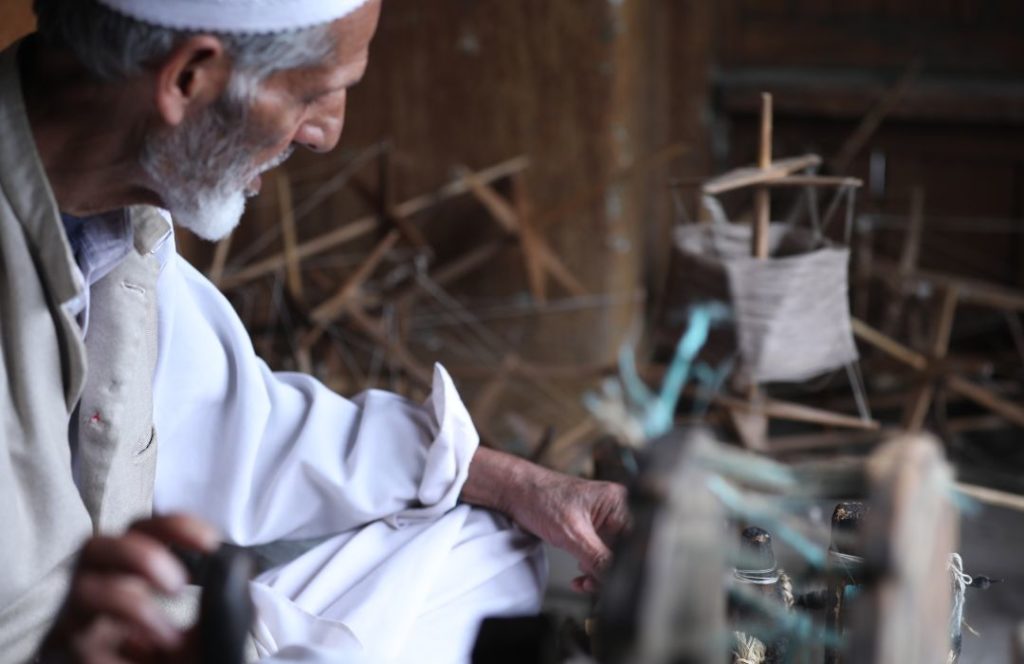
This spinning process is not merely a mechanical task but a labour of love and a tribute to tradition. The resulting yarn is delicate yet resilient, a testament to the exceptional qualities of Cashmere wool. Each thread spun by these artisans carries with it the history and heritage of Pashmina craftsmanship.
Weaving over the Loom
Now comes the time to weave the threads of Pashmina into enchanting fabrics, a process that unfolds on traditional handlooms. The weaving is undoubtedly an intricate dance of skill and patience. Artisans meticulously craft each piece of fabric with care and precision.
The handloom process is not for the hurried; it is a labor-intensive endeavour that demands time and dedication. It can take several days to weave a single piece of fabric, each moment infused with the artisan's expertise and reverence for their craft. The result is a fabric that is incredibly soft, lightweight, and imbued with the timeless warmth that characterizes Pashmina.
Exquisite Pashmina Production
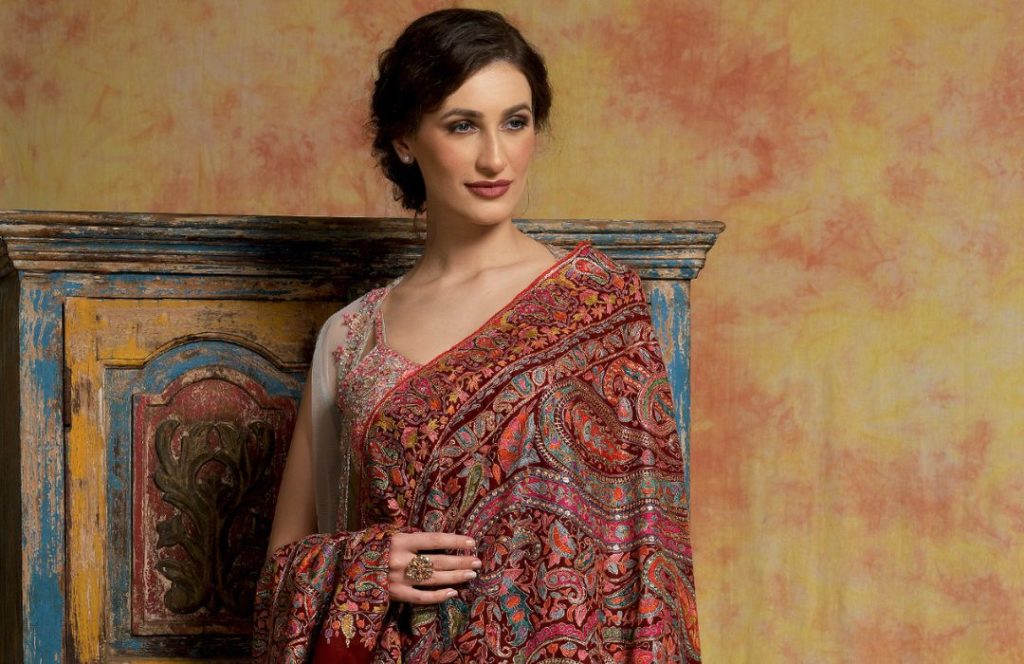
As the final threads are woven into the fabric, the journey of Pashmina production reaches its culmination - a culmination marked by the creation of luxurious shawls, scarves, and blankets. These exquisite products bear the imprint of centuries of tradition, the delicate touch of artisans, and the natural elegance of Cashmere fibres.
The legacy of Pashmina production is one that encapsulates the harmonious fusion of nature's bounty and human artistry. Each Pashmina creation carries with it a piece of the Himalayan landscape and the skilled hands that brought it to life. It is a testament to the enduring allure of craftsmanship and the timeless beauty of a textile tradition that has captured the world's imagination.
Also read: PASHMINA SHAWL: TESTIMONY OF THE TRAVELERS
Pashmina Goats and Sustainable Development
In the ethereal landscapes of the Himalayas, Pashmina goats stand as guardians of not only luxurious fibres but also sustainable development - a harmonious blend of economic vitality and environmental stewardship. Their profound role in this delicate balance unfolds through the Pashmina industry, where the threads of tradition, livelihoods, and conservation interweave.
Economic Empowerment Through Pashmina
The Pashmina industry casts a warm embrace on the economies of regions blessed with these graceful goats. It is a beacon of hope for countless individuals, offering a means of livelihood and economic sustenance. The industry, deeply rooted in tradition, provides employment opportunities for many, from the diligent shepherds who care for the Pashmina goats to the skilled artisans who craft exquisite Pashmina products.
This economic empowerment extends its reach, ensuring that communities in these regions thrive and prosper. By supporting sustainable management practices for Pashmina goat herds, the industry contributes to the long-term viability of these communities. It nurtures the roots of sustainable development, with each Pashmina product woven representing not just a textile but a lifeline to economic progress.
Pashmina Goats as Eco-Custodians
Pashmina goats are not just economic contributors; they are also environmental allies. These goats have evolved to thrive in the unforgiving high-altitude regions of the Himalayas, and their grazing habits can be harnessed to benefit the ecosystem. When managed thoughtfully, Pashmina goat herds contribute to the preservation of delicate grasslands and other natural habitats.
Their grazing patterns, if sustainable, can promote biodiversity and maintain the health of these fragile ecosystems. By preventing the overgrowth of certain plant species, they create space for diverse flora and fauna to flourish. The presence of these goats becomes an integral part of the intricate web of life in the Himalayas, aligning with principles of sustainable development.
Ethical and Environmental Responsibility in Pashmina Production
In the pursuit of sustainable development, the Pashmina industry bears a profound responsibility. Ethical considerations must be woven into the fabric of production. Pashmina goats must be treated with dignity and compassion, with their welfare prioritized at every stage.
Additionally, the industry must minimize its environmental footprint. Embracing eco-friendly production methods, reducing waste, and promoting responsible practices are essential steps. By adhering to these principles, the industry ensures that the production of Pashmina is not only economically viable but also environmentally responsible.
Pashmina Goats in Modern Culture
In the vibrant tapestry of popular culture, Pashmina goats have emerged as emblematic symbols of luxury and refinement, their influence spanning literature, art, fashion, and tourism. These regal creatures are celebrated for their elegance and grace, embodying a world of sophistication and grandeur. Let's embark on a journey through the various facets of their cultural significance.
Literary and Artistic Realms
Within the realm of literature and art, Pashmina goats are exalted as embodiments of exquisite beauty and sumptuousness. They appear as majestic beings, their soft, luxurious wool inspiring poets and artists alike. The renowned French writer Stéphane Mallarmé, for instance, penned a poetic ode to Pashmina goats, their softness and allure serving as metaphors for the finer pleasures of life.
These gentle creatures are often depicted in artistic creations as symbols of refinement and sophistication, a reminder of the innate connection between nature and human culture. The softness of their wool becomes a canvas for creative expression, evoking a sense of opulence and elegance that transcends the ordinary.
The Luxurious Legacy of Pashmina
In the realm of fashion, Pashmina goats reign supreme as purveyors of opulence. Their fine wool, celebrated for its unmatched softness and warmth, has become a cornerstone of high-end clothing and accessories. Pashmina shawls, scarves, and wraps are coveted by fashion aficionados worldwide, adorning the shoulders of those who seek both style and comfort.
The demand for Pashmina products has breathed life into a thriving industry, where skilled artisans craft exquisite pieces that grace fashion runways and find their way into the wardrobes of the discerning. Pashmina's legacy in fashion is one of enduring elegance, a testament to the timeless allure of its wool.
Tourism and Pashmina
Pashmina goats have also etched their presence in the realm of tourism, particularly in the regions where they graze. These regions have become popular destinations for travellers seeking to delve into the history and culture of Pashmina production.
Visitors have the opportunity to learn about the heritage of Pashmina, witnessing firsthand the artistry that transforms raw wool into luxurious textiles. They may even come face to face with Pashmina goats, admiring their unique characteristics and gaining insight into the symbiotic relationship between these graceful creatures and the communities that raise them.
Also read: KASHMIRI SHAWLS IN MID-VICTORIAN NOVELS
FAQ's about the Pashmina Goat
Here are a few unusual but important FAQs that customers asked us in the past years.
Q1: How do Pashmina goats survive such harsh climates?
Pashmina goats thrive in the unforgiving Himalayan climates due to their natural adaptations. Their dense woollen coats offer exceptional insulation against the cold, allowing them to endure freezing temperatures. These hardy creatures adeptly forage for sustenance amidst the meagre vegetation of the region, showcasing their resilience in the face of harsh environmental conditions.
Q2: What is the moulting season for Pashmina goats?
Pashmina goats undergo moulting, the shedding of their coveted fine undercoat, typically in the spring season. It is during this time that the valuable Pashmina fibres are carefully harvested, preserving their exceptional softness and quality.
Q3: How is Pashmina harvested from the goats?
Pashmina wool is obtained by delicately combing the soft undercoat of Pashmina goats during their moulting season. This process ensures the extraction of the prized wool without causing harm to the coarser outer fibres, preserving the quality and integrity of the Cashmere wool.
Q4: Can Pashmina goats be raised sustainably?
Indeed, the sustainable raising of Pashmina goats is achievable through conscientious grazing and herd management. When executed with care, these practices not only support the well-being of the goats but also contribute to the preservation of the ecosystem in their native habitat.
Q5: What are some popular Pashmina products?
Highly coveted for their exceptional softness and warmth, Pashmina products encompass a range of beloved items, including shawls, scarves, blankets, and wraps. These luxurious accessories are celebrated for their timeless appeal and versatility, adorning fashion-conscious individuals while cocooning them in unparalleled comfort.
Q6: How does the environment in which Pashmina goats are raised affect the quality of the wool?
The environment in which Pashmina goats are raised has a significant impact on the quality of the wool they produce. Pashmina goats thrive in the cold and harsh climates of the Himalayan region. Cold temperatures stimulate the growth of their fine undercoat, which is the source of Pashmina wool. The colder the climate, the finer and softer the wool tends to be.
When it comes to altitude, high-altitude regions, particularly in the Himalayas, are preferred for raising Pashmina goats. The lower oxygen levels at higher altitudes can stimulate the production of fine fibres. These areas also tend to have fewer parasites, reducing the risk of damage to the goats' wool
Food quality, too has an impact on the quality of Cashmere produced by Pashmina goats. The quality and availability of forage, including grasses, shrubs, and lichens, directly impact the goats' diet. A nutrient-rich diet from high-altitude vegetation contributes to healthier goats and finer wool.
With regard to the care taken of the goats and their management, these factors can be crucial too. Proper nutrition, regular grooming, and protection from extreme weather conditions all contribute to maintaining the health of the goats and the quality of their wool. Additionally, stress can negatively impact the quality of Pashmina wool. Environmental stressors like extreme cold, heat, or inadequate nutrition can lead to coarser fibres.
Genetics, too, play an important role when it comes to the quality of Cashmere The breed and genetics of Pashmina goats also play a role in determining wool quality. Some breeds are naturally predisposed to produce finer and softer Pashmina fibres.
Q7: Is there a relationship between the age of a Pashmina goat and the quality of its wool?
Yes, there is a relationship between the age of a Pashmina goat and the quality of its wool. Pashmina goats typically produce their finest and softest wool when they are young, particularly in their first year. The wool from yearling goats is highly prized for its exceptional softness and warmth. It has a shorter staple length, making it ideal for producing high-quality Pashmina products.
As Pashmina goats mature, generally between 2 to 4 years of age, they enter their prime wool-producing years. During this phase, the quality of the Pashmina fibre continues to improve. The fibres become finer, longer, and more consistent in diameter. Prime Pashmina wool is considered the best for crafting luxurious Pashmina textiles
As Pashmina goats age beyond their prime years, the quality of their wool may begin to decline. The fibres can become coarser, shorter, and less consistent in diameter. Older Pashmina goats may also produce less wool overall. However, with proper care and management, older goats can still provide valuable Cashmere wool.
Q8: What is the typical lifespan of Pashmina goats?
The longevity of Pashmina goats is contingent upon several variables, notably encompassing their dietary regimen, living environment, and susceptibility to diseases. These multifaceted influences culminate in an average life expectancy for Pashmina goats, which typically spans a range of 12 to 15 years. It is in this expanse of time that these creatures contribute to the rich tradition of Pashmina.
Also read: THE TRAIL OF INDIA’S CASHMERE GOAT MEN
Conclusion
Pashmina goats stand as remarkable beings with an enduring legacy deeply woven into the tapestry of Himalayan culture, economy, and ecology. Across centuries, their presence has left an indelible mark, thanks to their unique attributes, natural habitat, and the precious wool they produce. The Pashmina industry, in particular, has hinged on their contributions, leveraging their exquisite fleece to craft timeless, sought-after products. Simultaneously, their ability to not merely endure but thrive in the harshest of environmental conditions has been pivotal in sustaining the livelihoods of countless local communities.
These goats' distinctive physical characteristics, from their fine undercoats to their tenacity in high-altitude habitats, have sculpted their pivotal role. Their remarkable adaptability to the unforgiving Himalayan climate has been instrumental, in ensuring their survival and the perpetuation of this cherished industry.
As we cast our gaze towards the future, it becomes increasingly imperative to adopt sustainable practices in Pashmina production. This necessitates a harmonious blend of tradition and modernity, where the welfare of Pashmina goats is prioritized alongside the long-term viability of the industry. Sustainable methods not only safeguard these remarkable animals but also secure the cultural heritage and economic prosperity they represent.
Also read: WHAT IS PASHMINA WOOL & HOW IS IT DIFFERENT FROM OTHER WOOL?